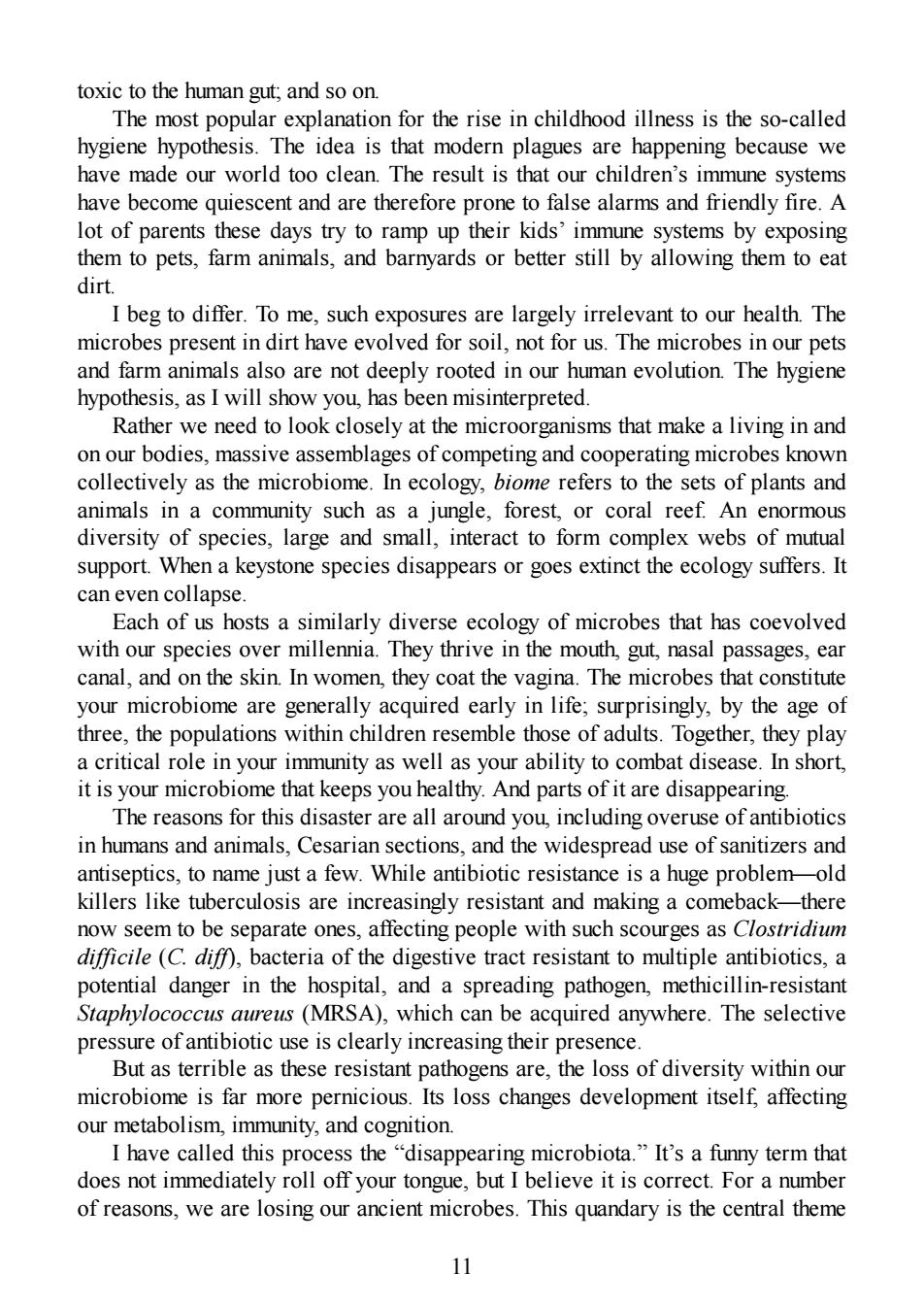
toxic to the human gut:and so on. The most popular explanation for the rise in childhood illness is the so-called hygiene hypothesis.The idea is that modern plagues are happening because we have made our world too clean.The result is that our children's immune systems have become quiescent and are therefore prone to false alarms and friendly fire.A lot of parents these days try to ramp up their kids'immune systems by exposing them to pets,farm animals,and barnyards or better still by allowing them to eat dirt. I beg to differ.To me,such exposures are largely irrelevant to our health.The microbes present in dirt have evolved for soil,not for us.The microbes in our pets and farm animals also are not deeply rooted in our human evolution.The hygiene hypothesis,as I will show you,has been misinterpreted. Rather we need to look closely at the microorganisms that make a living in and on our bodies,massive assemblages of competing and cooperating microbes known collectively as the microbiome.In ecology,biome refers to the sets of plants and animals in a community such as a jungle,forest,or coral reef.An enormous diversity of species,large and small,interact to form complex webs of mutual support.When a keystone species disappears or goes extinct the ecology suffers.It can even collapse. Each of us hosts a similarly diverse ecology of microbes that has coevolved with our species over millennia.They thrive in the mouth,gut,nasal passages,ear canal,and on the skin.In women,they coat the vagina.The microbes that constitute your microbiome are generally acquired early in life;surprisingly,by the age of three,the populations within children resemble those of adults.Together,they play a critical role in your immunity as well as your ability to combat disease.In short, it is your microbiome that keeps you healthy.And parts of it are disappearing The reasons for this disaster are all around you,including overuse of antibiotics in humans and animals.Cesarian sections,and the widespread use of sanitizers and antiseptics,to name just a few.While antibiotic resistance is a huge problem-old killers like tuberculosis are increasingly resistant and making a comeback-there now seem to be separate ones,affecting people with such scourges as Clostridium difficile (C.dim),bacteria of the digestive tract resistant to multiple antibiotics,a potential danger in the hospital,and a spreading pathogen,methicillin-resistant Staphylococcus aureus (MRSA),which can be acquired anywhere.The selective pressure of antibiotic use is clearly increasing their presence. But as terrible as these resistant pathogens are,the loss of diversity within our microbiome is far more pernicious.Its loss changes development itself,affecting our metabolism,immunity,and cognition I have called this process the "disappearing microbiota."It's a funny term that does not immediately roll off your tongue,but I believe it is correct.For a number of reasons,we are losing our ancient microbes.This quandary is the central theme 11
toxic to the human gut; and so on. The most popular explanation for the rise in childhood illness is the so-called hygiene hypothesis. The idea is that modern plagues are happening because we have made our world too clean. The result is that our children’s immune systems have become quiescent and are therefore prone to false alarms and friendly fire. A lot of parents these days try to ramp up their kids’ immune systems by exposing them to pets, farm animals, and barnyards or better still by allowing them to eat dirt. I beg to differ. To me, such exposures are largely irrelevant to our health. The microbes present in dirt have evolved for soil, not for us. The microbes in our pets and farm animals also are not deeply rooted in our human evolution. The hygiene hypothesis, as I will show you, has been misinterpreted. Rather we need to look closely at the microorganisms that make a living in and on our bodies, massive assemblages of competing and cooperating microbes known collectively as the microbiome. In ecology, biome refers to the sets of plants and animals in a community such as a jungle, forest, or coral reef. An enormous diversity of species, large and small, interact to form complex webs of mutual support. When a keystone species disappears or goes extinct the ecology suffers. It can even collapse. Each of us hosts a similarly diverse ecology of microbes that has coevolved with our species over millennia. They thrive in the mouth, gut, nasal passages, ear canal, and on the skin. In women, they coat the vagina. The microbes that constitute your microbiome are generally acquired early in life; surprisingly, by the age of three, the populations within children resemble those of adults. Together, they play a critical role in your immunity as well as your ability to combat disease. In short, it is your microbiome that keeps you healthy. And parts of it are disappearing. The reasons for this disaster are all around you, including overuse of antibiotics in humans and animals, Cesarian sections, and the widespread use of sanitizers and antiseptics, to name just a few. While antibiotic resistance is a huge problem—old killers like tuberculosis are increasingly resistant and making a comeback—there now seem to be separate ones, affecting people with such scourges as Clostridium dif icile (C. dif ), bacteria of the digestive tract resistant to multiple antibiotics, a potential danger in the hospital, and a spreading pathogen, methicillin-resistant Staphylococcus aureus (MRSA), which can be acquired anywhere. The selective pressure of antibiotic use is clearly increasing their presence. But as terrible as these resistant pathogens are, the loss of diversity within our microbiome is far more pernicious. Its loss changes development itself, affecting our metabolism, immunity, and cognition. I have called this process the “disappearing microbiota.” It’s a funny term that does not immediately roll off your tongue, but I believe it is correct. For a number of reasons, we are losing our ancient microbes. This quandary is the central theme 11
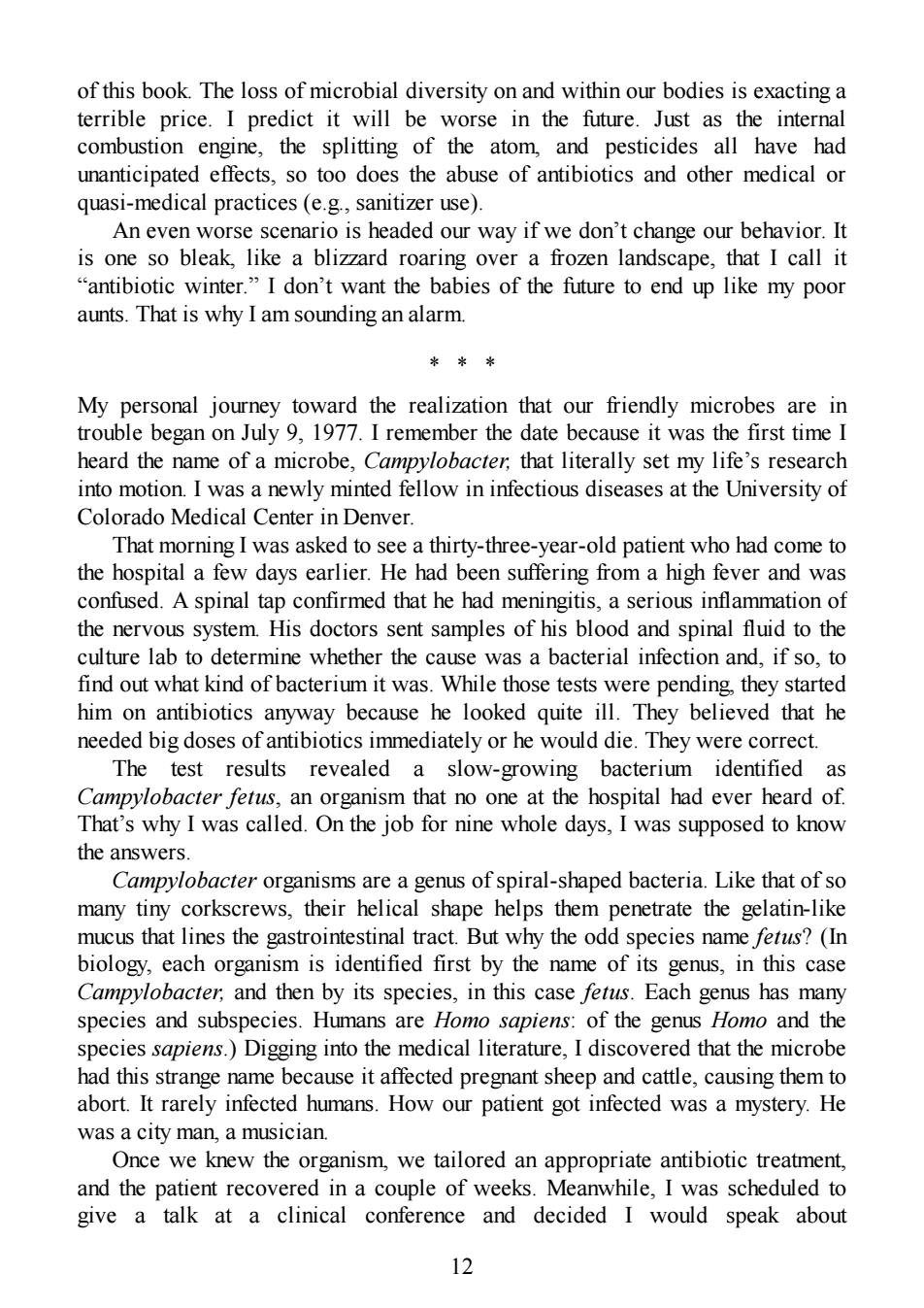
of this book.The loss of microbial diversity on and within our bodies is exacting a terrible price.I predict it will be worse in the future.Just as the internal combustion engine,the splitting of the atom,and pesticides all have had unanticipated effects,so too does the abuse of antibiotics and other medical or quasi-medical practices (e.g,sanitizer use). An even worse scenario is headed our way if we don't change our behavior.It is one so bleak,like a blizzard roaring over a frozen landscape,that I call it "antibiotic winter."I don't want the babies of the future to end up like my poor aunts.That is why I am sounding an alarm. My personal journey toward the realization that our friendly microbes are in trouble began on July 9,1977.I remember the date because it was the first time I heard the name of a microbe,Campylobacter.that literally set my life's research into motion.I was a newly minted fellow in infectious diseases at the University of Colorado Medical Center in Denver. That morning I was asked to see a thirty-three-year-old patient who had come to the hospital a few days earlier.He had been suffering from a high fever and was confused.A spinal tap confirmed that he had meningitis,a serious inflammation of the nervous system.His doctors sent samples of his blood and spinal fluid to the culture lab to determine whether the cause was a bacterial infection and,if so,to find out what kind of bacterium it was.While those tests were pending,they started him on antibiotics anyway because he looked quite ill.They believed that he needed big doses of antibiotics immediately or he would die.They were correct. The test results revealed a slow-growing bacterium identified as Campylobacter fetus,an organism that no one at the hospital had ever heard of. That's why I was called.On the job for nine whole days,I was supposed to know the answers Campylobacter organisms are a genus of spiral-shaped bacteria.Like that of so many tiny corkscrews,their helical shape helps them penetrate the gelatin-like mucus that lines the gastrointestinal tract.But why the odd species name fetus?(In biology,each organism is identified first by the name of its genus,in this case Campylobacter,and then by its species,in this case fetus.Each genus has many species and subspecies.Humans are Homo sapiens:of the genus Homo and the species sapiens.)Digging into the medical literature,I discovered that the microbe had this strange name because it affected pregnant sheep and cattle,causing them to abort.It rarely infected humans.How our patient got infected was a mystery.He was a city man,a musician. Once we knew the organism,we tailored an appropriate antibiotic treatment, and the patient recovered in a couple of weeks.Meanwhile.I was scheduled to give a talk at a clinical conference and decided I would speak about 12
of this book. The loss of microbial diversity on and within our bodies is exacting a terrible price. I predict it will be worse in the future. Just as the internal combustion engine, the splitting of the atom, and pesticides all have had unanticipated effects, so too does the abuse of antibiotics and other medical or quasi-medical practices (e.g., sanitizer use). An even worse scenario is headed our way if we don’t change our behavior. It is one so bleak, like a blizzard roaring over a frozen landscape, that I call it “antibiotic winter.” I don’t want the babies of the future to end up like my poor aunts. That is why I am sounding an alarm. * * * My personal journey toward the realization that our friendly microbes are in trouble began on July 9, 1977. I remember the date because it was the first time I heard the name of a microbe, Campylobacter, that literally set my life’s research into motion. I was a newly minted fellow in infectious diseases at the University of Colorado Medical Center in Denver. That morning I was asked to see a thirty-three-year-old patient who had come to the hospital a few days earlier. He had been suffering from a high fever and was confused. A spinal tap confirmed that he had meningitis, a serious inflammation of the nervous system. His doctors sent samples of his blood and spinal fluid to the culture lab to determine whether the cause was a bacterial infection and, if so, to find out what kind of bacterium it was. While those tests were pending, they started him on antibiotics anyway because he looked quite ill. They believed that he needed big doses of antibiotics immediately or he would die. They were correct. The test results revealed a slow-growing bacterium identified as Campylobacter fetus, an organism that no one at the hospital had ever heard of. That’s why I was called. On the job for nine whole days, I was supposed to know the answers. Campylobacter organisms are a genus of spiral-shaped bacteria. Like that of so many tiny corkscrews, their helical shape helps them penetrate the gelatin-like mucus that lines the gastrointestinal tract. But why the odd species name fetus? (In biology, each organism is identified first by the name of its genus, in this case Campylobacter, and then by its species, in this case fetus. Each genus has many species and subspecies. Humans are Homo sapiens: of the genus Homo and the species sapiens.) Digging into the medical literature, I discovered that the microbe had this strange name because it affected pregnant sheep and cattle, causing them to abort. It rarely infected humans. How our patient got infected was a mystery. He was a city man, a musician. Once we knew the organism, we tailored an appropriate antibiotic treatment, and the patient recovered in a couple of weeks. Meanwhile, I was scheduled to give a talk at a clinical conference and decided I would speak about 12
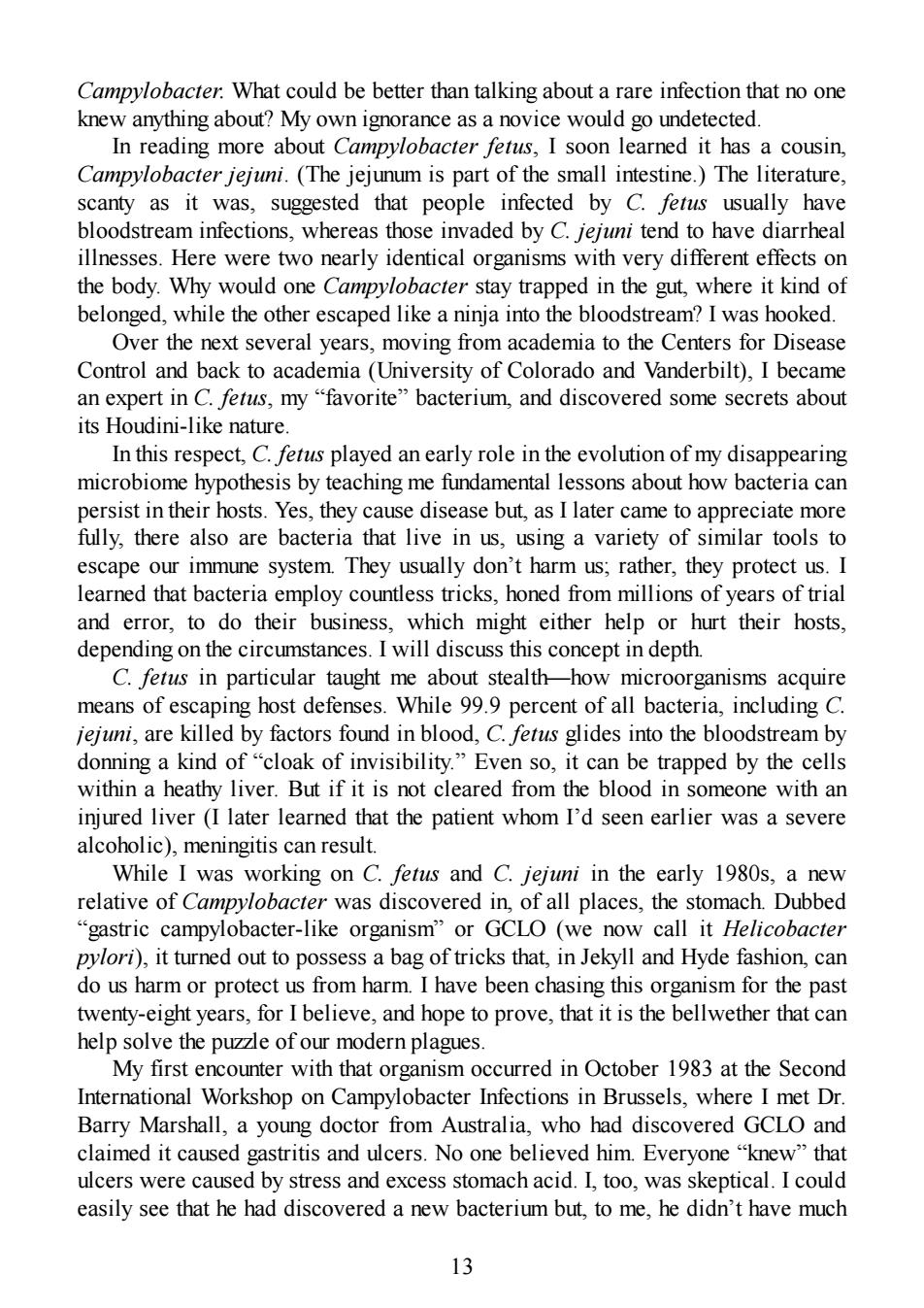
Campylobacter:What could be better than talking about a rare infection that no one knew anything about?My own ignorance as a novice would go undetected. In reading more about Campylobacter fetus,I soon learned it has a cousin. Campylobacter jejuni.(The jejunum is part of the small intestine.)The literature, scanty as it was,suggested that people infected by C.fetus usually have bloodstream infections,whereas those invaded by C.jejuni tend to have diarrheal illnesses.Here were two nearly identical organisms with very different effects on the body.Why would one Campylobacter stay trapped in the gut,where it kind of belonged,while the other escaped like a ninja into the bloodstream?I was hooked. Over the next several years,moving from academia to the Centers for Disease Control and back to academia(University of Colorado and Vanderbilt),I became an expert in C.fetus,my "favorite"bacterium,and discovered some secrets about its Houdini-like nature In this respect,C.fetus played an early role in the evolution of my disappearing microbiome hypothesis by teaching me fundamental lessons about how bacteria can persist in their hosts.Yes,they cause disease but,as I later came to appreciate more fully,there also are bacteria that live in us,using a variety of similar tools to escape our immune system.They usually don't harm us;rather,they protect us.I learned that bacteria employ countless tricks,honed from millions of years of trial and error,to do their business,which might either help or hurt their hosts, depending on the circumstances.I will discuss this concept in depth C.fetus in particular taught me about stealth-how microorganisms acquire means of escaping host defenses.While 99.9 percent of all bacteria,including C jejuni,are killed by factors found in blood.C.fetus glides into the bloodstream by donning a kind of"cloak of invisibility."Even so,it can be trapped by the cells within a heathy liver.But if it is not cleared from the blood in someone with an injured liver(I later learned that the patient whom I'd seen earlier was a severe alcoholic).meningitis can result. While I was working on C.fetus and C.jejuni in the early 1980s,a new relative of Campylobacter was discovered in,of all places,the stomach.Dubbed "gastric campylobacter-like organism"or GCLO (we now call it Helicobacter pylori),it turned out to possess a bag of tricks that,in Jekyll and Hyde fashion,can do us harm or protect us from harm.I have been chasing this organism for the past twenty-eight years,for I believe,and hope to prove,that it is the bellwether that can help solve the puzzle of our modern plagues My first encounter with that organism occurred in October 1983 at the Second International Workshop on Campylobacter Infections in Brussels,where I met Dr. Barry Marshall,a young doctor from Australia,who had discovered GCLO and claimed it caused gastritis and ulcers.No one believed him.Everyone "knew"that ulcers were caused by stress and excess stomach acid.I,too,was skeptical.I could easily see that he had discovered a new bacterium but,to me,he didn't have much 13
Campylobacter. What could be better than talking about a rare infection that no one knew anything about? My own ignorance as a novice would go undetected. In reading more about Campylobacter fetus, I soon learned it has a cousin, Campylobacter jejuni. (The jejunum is part of the small intestine.) The literature, scanty as it was, suggested that people infected by C. fetus usually have bloodstream infections, whereas those invaded by C. jejuni tend to have diarrheal illnesses. Here were two nearly identical organisms with very different effects on the body. Why would one Campylobacter stay trapped in the gut, where it kind of belonged, while the other escaped like a ninja into the bloodstream? I was hooked. Over the next several years, moving from academia to the Centers for Disease Control and back to academia (University of Colorado and Vanderbilt), I became an expert in C. fetus, my “favorite” bacterium, and discovered some secrets about its Houdini-like nature. In this respect, C. fetus played an early role in the evolution of my disappearing microbiome hypothesis by teaching me fundamental lessons about how bacteria can persist in their hosts. Yes, they cause disease but, as I later came to appreciate more fully, there also are bacteria that live in us, using a variety of similar tools to escape our immune system. They usually don’t harm us; rather, they protect us. I learned that bacteria employ countless tricks, honed from millions of years of trial and error, to do their business, which might either help or hurt their hosts, depending on the circumstances. I will discuss this concept in depth. C. fetus in particular taught me about stealth—how microorganisms acquire means of escaping host defenses. While 99.9 percent of all bacteria, including C. jejuni, are killed by factors found in blood, C. fetus glides into the bloodstream by donning a kind of “cloak of invisibility.” Even so, it can be trapped by the cells within a heathy liver. But if it is not cleared from the blood in someone with an injured liver (I later learned that the patient whom I’d seen earlier was a severe alcoholic), meningitis can result. While I was working on C. fetus and C. jejuni in the early 1980s, a new relative of Campylobacter was discovered in, of all places, the stomach. Dubbed “gastric campylobacter-like organism” or GCLO (we now call it Helicobacter pylori), it turned out to possess a bag of tricks that, in Jekyll and Hyde fashion, can do us harm or protect us from harm. I have been chasing this organism for the past twenty-eight years, for I believe, and hope to prove, that it is the bellwether that can help solve the puzzle of our modern plagues. My first encounter with that organism occurred in October 1983 at the Second International Workshop on Campylobacter Infections in Brussels, where I met Dr. Barry Marshall, a young doctor from Australia, who had discovered GCLO and claimed it caused gastritis and ulcers. No one believed him. Everyone “knew” that ulcers were caused by stress and excess stomach acid. I, too, was skeptical. I could easily see that he had discovered a new bacterium but, to me, he didn’t have much 13
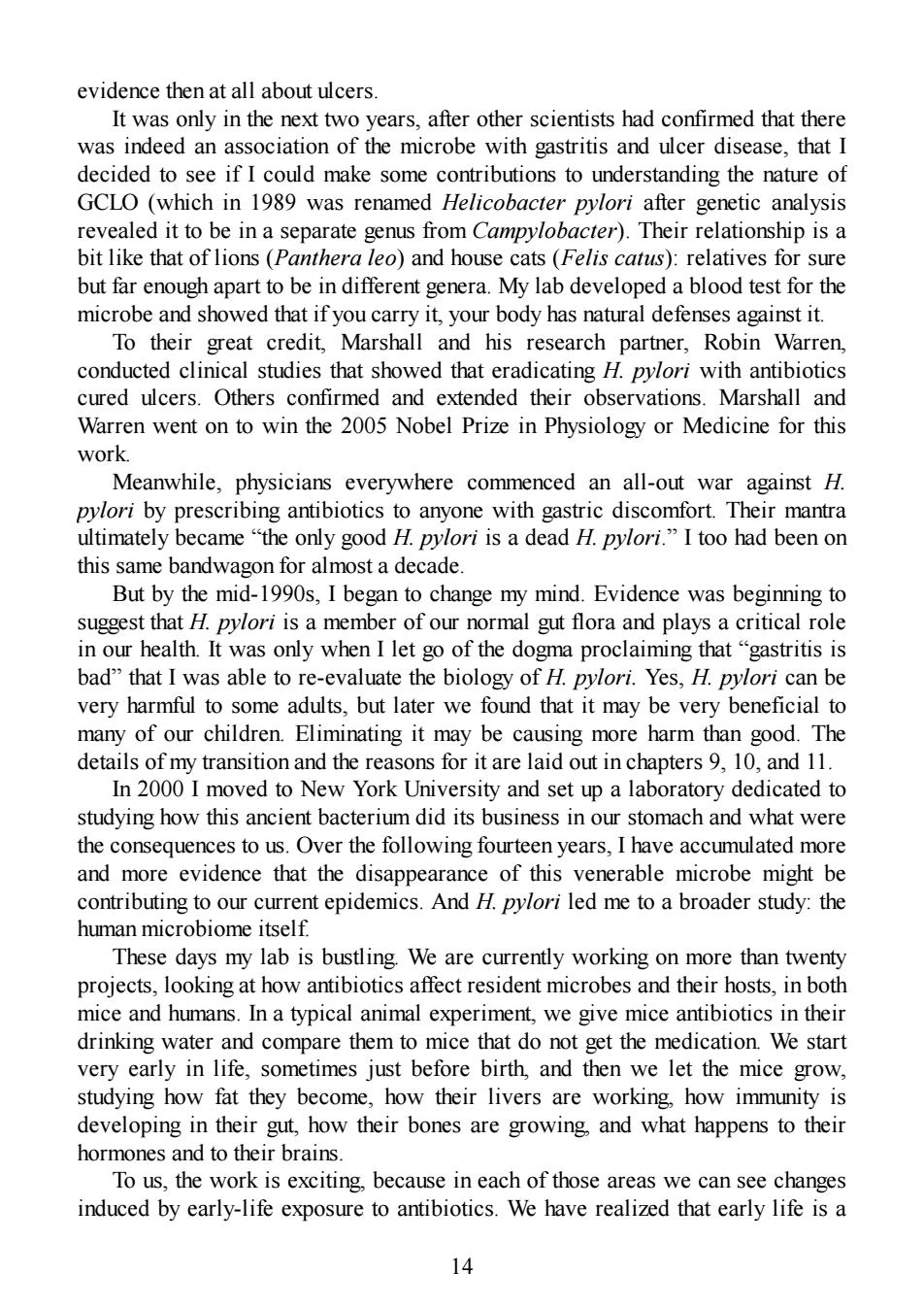
evidence then at all about ulcers. It was only in the next two years,after other scientists had confirmed that there was indeed an association of the microbe with gastritis and ulcer disease,that I decided to see if I could make some contributions to understanding the nature of GCLO (which in 1989 was renamed Helicobacter pylori after genetic analysis revealed it to be in a separate genus from Campylobacter).Their relationship is a bit like that of lions (Panthera leo)and house cats (Felis catus):relatives for sure but far enough apart to be in different genera.My lab developed a blood test for the microbe and showed that if you carry it,your body has natural defenses against it. To their great credit,Marshall and his research partner,Robin Warren, conducted clinical studies that showed that eradicating H.pylori with antibiotics cured ulcers.Others confirmed and extended their observations.Marshall and Warren went on to win the 2005 Nobel Prize in Physiology or Medicine for this work Meanwhile,physicians everywhere commenced an all-out war against H pylori by prescribing antibiotics to anyone with gastric discomfort.Their mantra ultimately became"the only good H.pylori is a dead H.pylori."I too had been on this same bandwagon for almost a decade. But by the mid-1990s,I began to change my mind.Evidence was beginning to suggest that H.pylori is a member of our normal gut flora and plays a critical role in our health.It was only when I let go of the dogma proclaiming that"gastritis is bad"that I was able to re-evaluate the biology of H.pylori.Yes,H.pylori can be very harmful to some adults,but later we found that it may be very beneficial to many of our children.Eliminating it may be causing more harm than good.The details of my transition and the reasons for it are laid out in chapters 9,10,and 11. In 2000 I moved to New York University and set up a laboratory dedicated to studying how this ancient bacterium did its business in our stomach and what were the consequences to us.Over the following fourteen years,I have accumulated more and more evidence that the disappearance of this venerable microbe might be contributing to our current epidemics.And H.pylori led me to a broader study:the human microbiome itself. These days my lab is bustling We are currently working on more than twenty projects,looking at how antibiotics affect resident microbes and their hosts,in both mice and humans.In a typical animal experiment,we give mice antibiotics in their drinking water and compare them to mice that do not get the medication.We start very early in life,sometimes just before birth,and then we let the mice grow. studying how fat they become,how their livers are working,how immunity is developing in their gut,how their bones are growing and what happens to their hormones and to their brains. To us,the work is exciting,because in each of those areas we can see changes induced by early-life exposure to antibiotics.We have realized that early life is a
evidence then at all about ulcers. It was only in the next two years, after other scientists had confirmed that there was indeed an association of the microbe with gastritis and ulcer disease, that I decided to see if I could make some contributions to understanding the nature of GCLO (which in 1989 was renamed Helicobacter pylori after genetic analysis revealed it to be in a separate genus from Campylobacter). Their relationship is a bit like that of lions (Panthera leo) and house cats (Felis catus): relatives for sure but far enough apart to be in different genera. My lab developed a blood test for the microbe and showed that if you carry it, your body has natural defenses against it. To their great credit, Marshall and his research partner, Robin Warren, conducted clinical studies that showed that eradicating H. pylori with antibiotics cured ulcers. Others confirmed and extended their observations. Marshall and Warren went on to win the 2005 Nobel Prize in Physiology or Medicine for this work. Meanwhile, physicians everywhere commenced an all-out war against H. pylori by prescribing antibiotics to anyone with gastric discomfort. Their mantra ultimately became “the only good H. pylori is a dead H. pylori.” I too had been on this same bandwagon for almost a decade. But by the mid-1990s, I began to change my mind. Evidence was beginning to suggest that H. pylori is a member of our normal gut flora and plays a critical role in our health. It was only when I let go of the dogma proclaiming that “gastritis is bad” that I was able to re-evaluate the biology of H. pylori. Yes, H. pylori can be very harmful to some adults, but later we found that it may be very beneficial to many of our children. Eliminating it may be causing more harm than good. The details of my transition and the reasons for it are laid out in chapters 9, 10, and 11. In 2000 I moved to New York University and set up a laboratory dedicated to studying how this ancient bacterium did its business in our stomach and what were the consequences to us. Over the following fourteen years, I have accumulated more and more evidence that the disappearance of this venerable microbe might be contributing to our current epidemics. And H. pylori led me to a broader study: the human microbiome itself. These days my lab is bustling. We are currently working on more than twenty projects, looking at how antibiotics affect resident microbes and their hosts, in both mice and humans. In a typical animal experiment, we give mice antibiotics in their drinking water and compare them to mice that do not get the medication. We start very early in life, sometimes just before birth, and then we let the mice grow, studying how fat they become, how their livers are working, how immunity is developing in their gut, how their bones are growing, and what happens to their hormones and to their brains. To us, the work is exciting, because in each of those areas we can see changes induced by early-life exposure to antibiotics. We have realized that early life is a 14
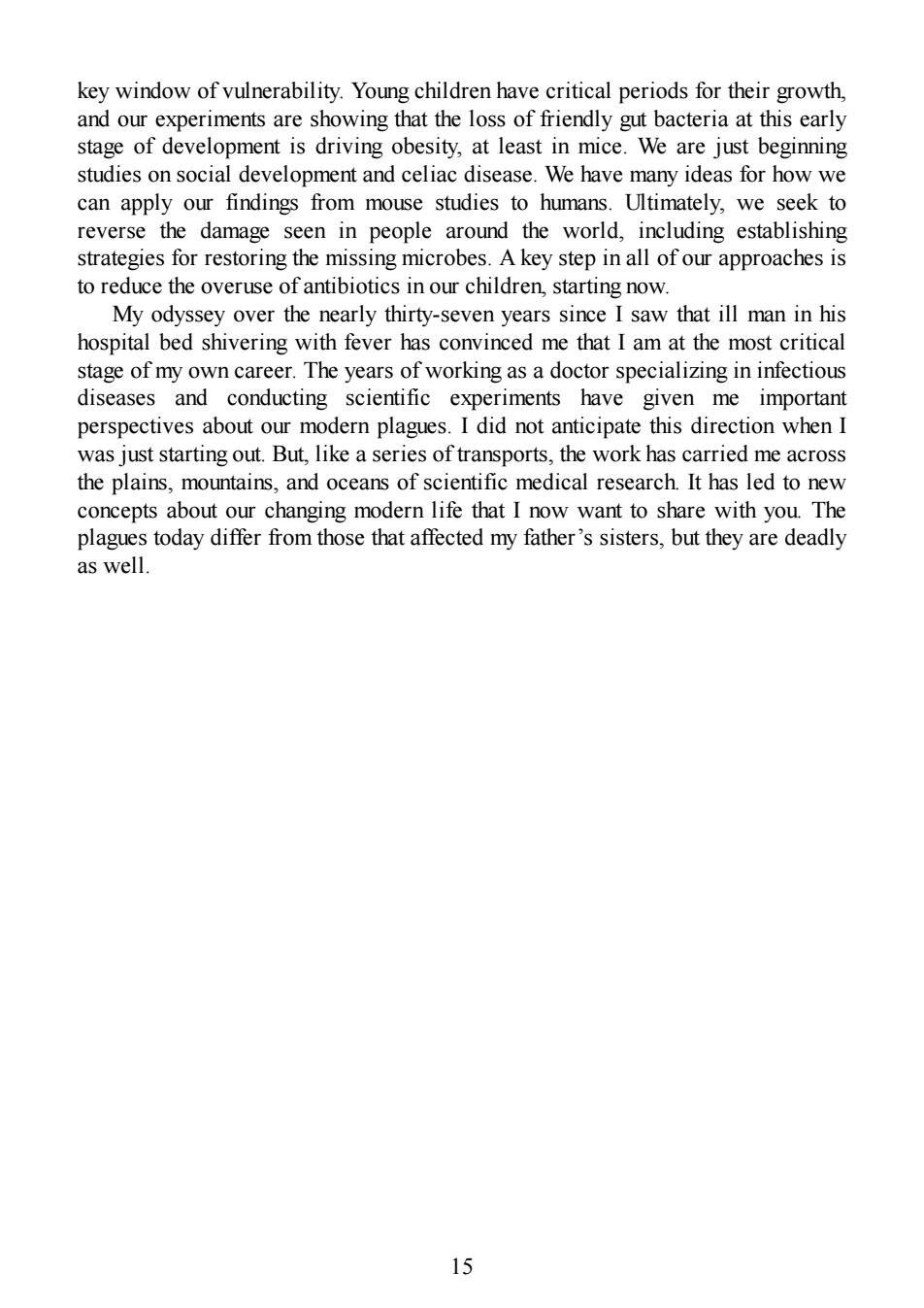
key window of vulnerability.Young children have critical periods for their growth, and our experiments are showing that the loss of friendly gut bacteria at this early stage of development is driving obesity,at least in mice.We are just beginning studies on social development and celiac disease.We have many ideas for how we can apply our findings from mouse studies to humans.Ultimately,we seek to reverse the damage seen in people around the world,including establishing strategies for restoring the missing microbes.A key step in all of our approaches is to reduce the overuse of antibiotics in our children,starting now. My odyssey over the nearly thirty-seven years since I saw that ill man in his hospital bed shivering with fever has convinced me that I am at the most critical stage of my own career.The years of working as a doctor specializing in infectious diseases and conducting scientific experiments have given me important perspectives about our modern plagues.I did not anticipate this direction when I was just starting out.But,like a series of transports,the work has carried me across the plains,mountains,and oceans of scientific medical research.It has led to new concepts about our changing modern life that I now want to share with you.The plagues today differ from those that affected my father's sisters,but they are deadly as well. 6
key window of vulnerability. Young children have critical periods for their growth, and our experiments are showing that the loss of friendly gut bacteria at this early stage of development is driving obesity, at least in mice. We are just beginning studies on social development and celiac disease. We have many ideas for how we can apply our findings from mouse studies to humans. Ultimately, we seek to reverse the damage seen in people around the world, including establishing strategies for restoring the missing microbes. A key step in all of our approaches is to reduce the overuse of antibiotics in our children, starting now. My odyssey over the nearly thirty-seven years since I saw that ill man in his hospital bed shivering with fever has convinced me that I am at the most critical stage of my own career. The years of working as a doctor specializing in infectious diseases and conducting scientific experiments have given me important perspectives about our modern plagues. I did not anticipate this direction when I was just starting out. But, like a series of transports, the work has carried me across the plains, mountains, and oceans of scientific medical research. It has led to new concepts about our changing modern life that I now want to share with you. The plagues today differ from those that affected my father’s sisters, but they are deadly as well. 15